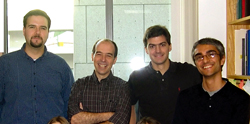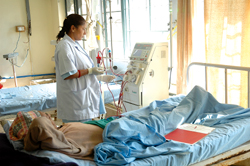|
|
Every year thousands of Nepalis die of diarrhoea, close to a million have to live with uterine prolapse, and a handful learn that the cost of being haemophiliac might be living outside Nepal.
There are other medical conditions, not part of any development discourse, that go undetected or are harder to live with here than in many other South Asian countries. It doesn't matter if you're in Kathmandu and are middle class. For disorders like Alzheimer's or kidney disease, options for treatment and even diagnosis are few.
No one knows much about Alzheimer's disease, but in Nepal we know almost nothing. When an elderly relative fails to remember names or faces, recognise objects, or speak in coherent sentences, is that par-for-the course senility, mental illness, or something else? Some estimates put the incidence of mental illness in Nepal at over 25 percent of the population. No one will even venture a guess at how many of these diagnoses are actually people with Alzheimer's.
Alzheimer's disease usually strikes after the age of 65, but can occur as early as 45. A degenerative disorder, it attacks the brain and leads to dementia, as the brain's cognitive centres are affected, causing memory loss and trouble comprehending logical patterns. As the disease progresses, social interactions diminish, and those afflicted lose the ability to care for themselves. People with Alzheimer's can live for as long as 20 years with the disease. Yet they are rarely diagnosed. "Nepalis tend to associate mental illness with old age and don't take the matter seriously," says Dr Dhruba Raj Adhikari, a neurosurgeon at Bir Hospital.
The best way to diagnose Alzheimer's is through chromosomal analysis, a test not yet available in Nepal. The alternative is to conduct a battery of tests that costs well over Rs 15,000. "We have to rule out other diseases first, so the investigation becomes expensive," says Dr Adhikari.
But most Nepalis can't even afford the basic Rs 2,700 CT scan, and for those who can, there are few hospitals where all the tests can be carried out. The well-equipped National Institute of Neurology at Bansbari costs twice more than state-owned Bir Hospital, where patients have to pay Rs 110 for a bed-and all test costs, which range from Rs 120 for a chest x-ray, to as much as Rs 15,000 for a biopsy.
There is no cure for Alzheimer's yet, but recent findings by a Harvard research team, which includes a Nepali scientist, suggest there is hope for the future. (See box.) For now, addressing the symptoms is the only alternative. "With early diagnosis the patient can take drugs which can help them improve their memory, and they can also receive supportive care from families by being placed in familiar surroundings," says Dr Adhikari. When the disease is diagnosed, the patient's family must then rely on the goodwill of people who travel abroad to bring back new medication.
Now imagine that you have kidney disease, and need a transplant or regular dialysis. At Bir Hospital, which has five working dialysis machines, the facilities are overbooked and under-staffed. The hospital, one of only eight places that offers haemodialysis in Nepal, is turning away all new patients, because it can barely provide services to the old ones.
Bhubaneshwar Sharma, 78, has been on dialysis for over two years now. He needs to be in hospital twice a week for four-hour sessions. But often there are emergency cases, and he is forced to settle for two or maybe three hours. His doctor, Sudha Khakurel, admits that this affects the quality of Sharma's life, but says, "we have to adjust to take in emergency patients."
Dialysis in private hospitals costs from Rs 16,000 to 24,000 a month, while at Bir Hospital it is Rs 8,000. "It's a sin for a poor man to have this disease," says Sharma, who has had to sell his land to stay alive, and is worried he won't have any money left to get his youngest daughter married.
There are 60 dialysis machines in Nepal, and 8,000-10,000 patients who report for treatment regularly. Do the math. If one patient needs on average eight hours of treatment a week, to serve all these people with acute or chronic renal disease, we need at least 230 more machines.
Of six dialysis machines at Bir Hospital, one does not work any more. The remaining ones constantly break down, usually because of voltage fluctuations. Repair is costly, and spare parts have to be imported. "We have six other machines which were donated, but the instructions are in Japanese. We can't use them properly, so we have to send them back," says Dr Khakurel.
The number of Nepalis with acute or renal kidney failure is increasing by about 2,000 every year. Of these, 150-180 come to Bir Hospital, mainly because it
is cheaper.
Kidney transplants are often the only viable long-term option, but the expense deters people, as does the fact that most Nepalis go to the All India Institute of Medical Sciences (where a kidney transplant costs Rs 200-300,000). "Dialysis will continue to be the preference of the poor, unless there is a mechanism to reduce the cost of transplants," says Dr Khakurel.
BREAKTHROUGH
 |
| L to R: Joshua Murtie, Gabriel Corfas, Pablo Sardi, and Samir Koirala. |
The recently-published findings of a four-year study by the team suggest that a molecule long suspected to play a role in Alzheimer's also works to regulate development of the human brain and neurons. The team's findings have spurred the development of drugs that target the molecule, slowing the progress of the disease. The clinical trials will take time, but this is still the closest researchers have come to proposing anything like direct treatment for Alzheimer's.
In the embryonic brain, a protein called erbB4 on the surface of stem cells helps create various cell types. The team discovered that erbB4 gets cut by another protein, called presenilin, a factor in Alzheimer's disease.
Researchers have known for several years that in the brains of Alzheimer's patients, erbB4 is accumulated around amyloid plaques. What they didn't know was how this contributes to the disease. Their research now shows that excessive erbB4 could inappropriately suppress genes and lead to dysfunction or death of nerve cells. It also suggests the interesting possibility that some cases of Alzheimer's may have their roots in the defective development of brain cells during the beginning of life.
Drugs are being developed to target presenilin function and inhibit the accumulation of amyloid plaques in the brains of Alzheimer's patients, preventing neuron death, which would huge step forward. Early clinical trials are on and, if effective, such drugs could be available in just a few years.



